


Stephen Partleton (1801-1836)
Some of our readers in the UK may have seen the recent adverts [2010] for ancestry.co.uk on television. Various ancestors are shown sitting up trees, dropping leaves on the living, unseen, hiding round corners etc. etc. And they whisper...
"... find us ..."
Stephen Partleton may be the last 19th century Partleton to be found...
For a long time, all we had to show us that he ever existed was this 1834 document:

At time of writing of this web page, there was no record of Stephen's birth or baptism, but above we see his signature, bold as brass - witness at the wedding of William Partleton (1808-1868) and Ann Milligan (1809-1873), at the church of St Mary Newington near the Elephant & Castle.
Here's the church. I've used this picture before, but it's a nice one and it's a perfect perspective of the location, even though the belfry of the church was soon to change:
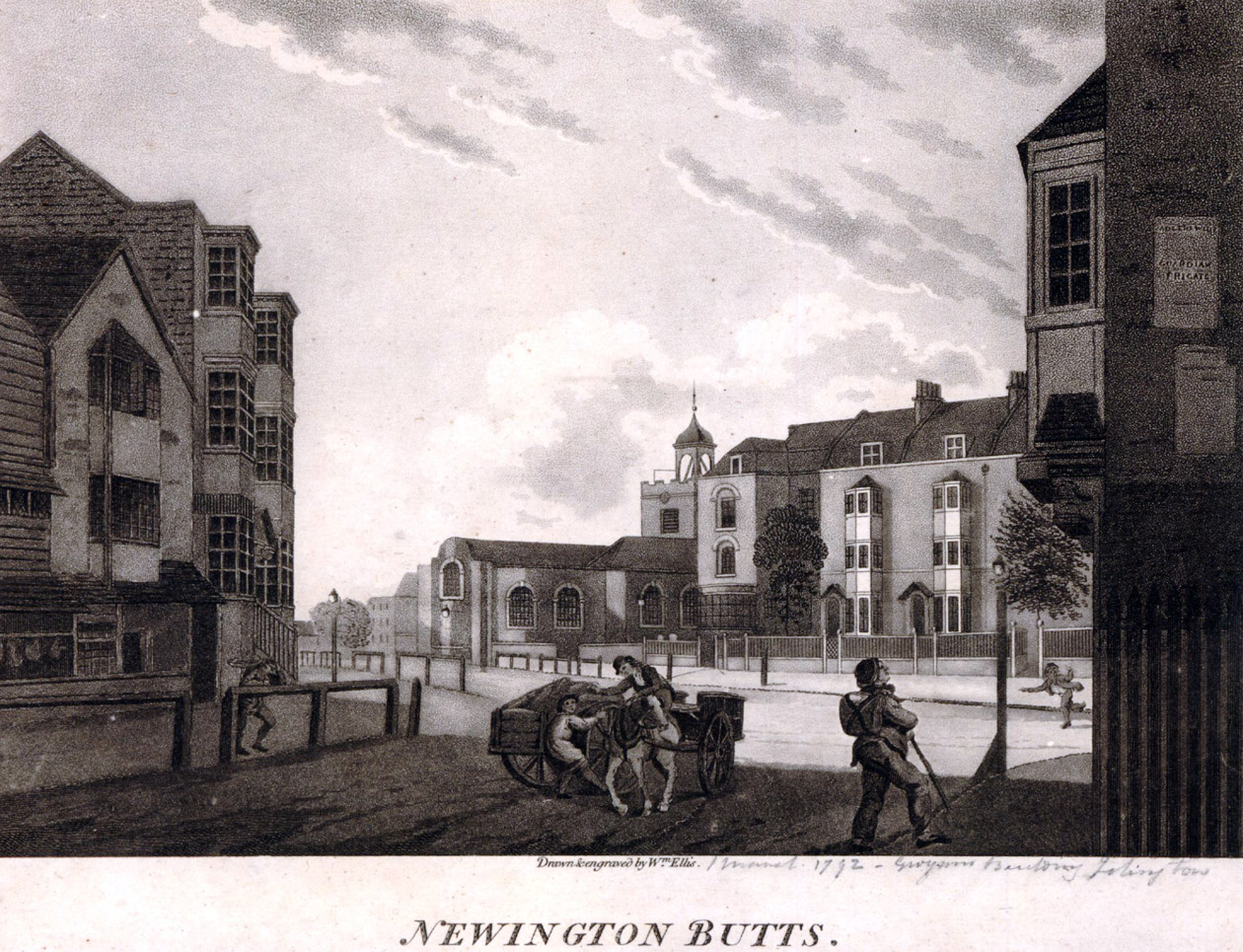
This quirky 18th-century engraving by artist William Ellis above was drawn from Cross Street, Newington, from the viewpoint of the green arrow in the map below:

Just to be clear where we are, here's the location of Newington, circled in yellow, in the bigger picture of London:

So, let's step into Stephen's shoes, sign the Parish Register, and step blinking out of the darkness of the church into a bright February day. Perhaps there'll be a few drinks after the wedding:

The painting above is seen from the viewpoint of the red arrow in the map below:

I'll bring back that earlier print so we can get our bearings:

The east window in the nearest part of the church in the engraving above is clearly on the High Street, but when we compare it with the window in the foreground of the 1825 watercolour below, we find it doesn't really match:

This watercolour was painted by artist John Hassell in 1825, just nine years before Stephen Partleton stood on this very spot. The title 'North Entrance to the Village of Newington Butts' tells us that in 1825, Newington can still genuinely be described as a village - which is what it had been for 600 years. By the time Stephen is in Newington, in 1834, it's already being inexorably engulfed by the unstoppable expansion of London.
To resolve the difference in the church window, let's have a look at an earlier engraving of St Mary Newington of 1750:
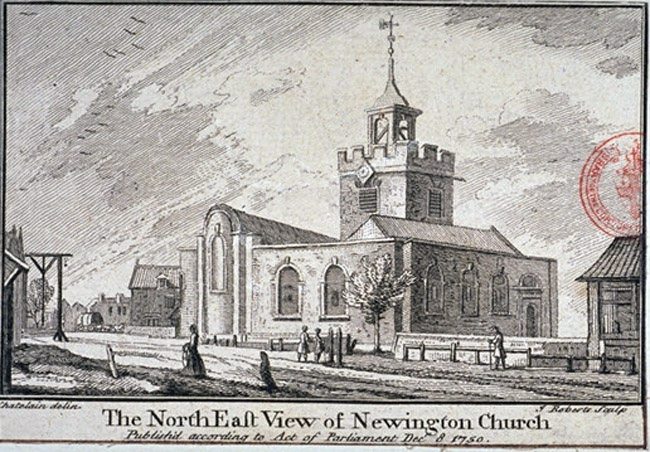
The above picture, with people walking along Newington High Street, is from the yellow arrow in the map:

And the artist was kind enough to give us the opposite view, from the purple arrow:
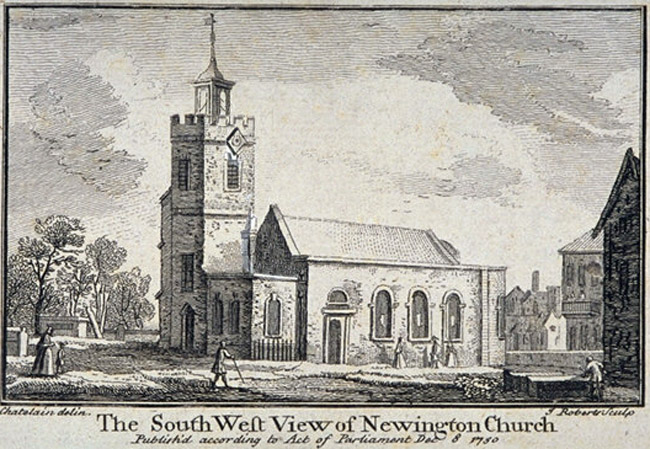
And finally, below, we can see the church as Stephen saw it on 10 February 1834, from the orange arrow in the map. There had been two major remodellings, in 1793 - when the portico (the bit on the front with the pillars) was added, and the church was enlarged, and again 1810. The tower is the same - one presumes - but the belfry has been replaced:

I think the house picked out by the light blue arrow in the picture above can be matched to one of the ones in the distance along Newington Butts in the 1825 watercolour:

"Why was it called Newington Butts?", I hear you ask, and maybe you didn't ask, but I 'm going to answer. Butts were archery ranges. In a previous age, possession of a longbow, and regular practice of archery were compulsory.
Here's a Royal Statute reinforced by Henry VIII in 1515:

Henry was very careful to specify longbows. These were very difficult to use, but once mastered, they were unbeatable and were the English army's 'super-weapon' for centuries. Crossbows were much easier to use than longbows, but took three times as long to reload. If you were a crossbowman facing longbow archers, you would perish in a rain of arrows.
Consequently, ownership and use of crossbows was illegal in England.
So, in this excellent surviving 16th-Century engraving of a butts from the Royal Library, which we may use to envisage Newington Butts, we are surprised to see crossbows:
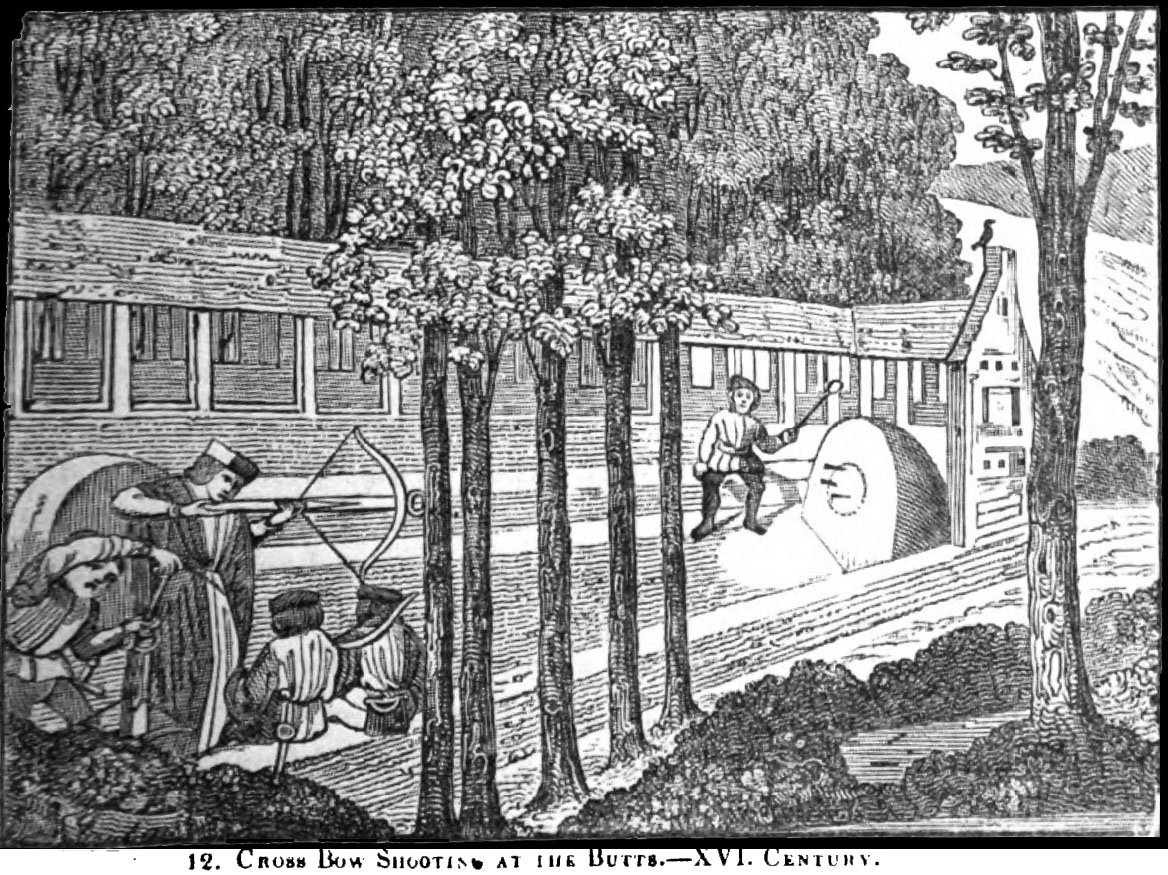
This picture is taken from The Sports and Pastimes of the People of England, published in 1801 by Joseph Strutt. The Butt is actually the target [the original meaning is possibly a tree stump or log].
Joseph explains why we see crossbows in the picture. Regardless of the law, crossbows remained popular - you just couldn't stop people getting hold of them and playing with them:

I've read that the term butts may not necessarily signify an archery range, and we can't be sure there was one at Newington...
But even in Stanford's map of 1862, with the church of St Mary Newington circled in blue, over 300 years since Henry VIII died, in the Victorian age of rifles and cannons, we find an archery ground - hardly a notably Victorian activity - circled in red, though perhaps not quite at the original location of Newington Butts:

The archaic meaning of butt as target or goal is used by Shakespeare, much to the hilarity of schoolboys when they read Othello's lines in Act V:
![]()
That's enough butts. We're not finished with that marriage record yet:

Stephen is literate, and signs his own name as Stephen Partleton Sr. This just muddies the water further, because Sr. implies that there must be a Jr., yet we have no births for any Stephen Partletons in London in the 1700s or 1800s.
So, what relationship has our Stephen to the groom, William, married on that day? Let's have a look at William's immediate family:

William Partleton's mum and dad, Benjamin and Catherine, have seven children over a period of fifteen years, with great regularity... except when we look at the intervals, we find that there's a big gap, like a missing tooth, between the years 1799 to 1804. This is one of those clues which the genealogist can use. It was an age before contraception; did Benjamin and Catherine really go five years without a baby?
Of course there might have been a baby which died or was stillborn, and certainly burial records are patchy. But we could also speculate that Stephen might be William's brother, and he might have been born about 1802. And we did speculate, but without any evidence, that's all we could do.
And then, in 2009, ancestry.co.uk added indexed records of the Burial Registers for London Parishes from 1813 to the present-day to their database. As mentioned, burial records are not complete and yielded just eight Partleton burials, all of whom were previously known to us, but did give the benefit of some excellent scans of the original registers.
But wait, what's this, unearthed by Terry Partleton? ...

There’s no such name as Partlington. Don’t take my word for it, check it out for yourself: there are none in any UK census from 1841 to 1911. There’s one birth recorded in 1858, which turns out to be an error, and there’s one death – the one we see above, Stephen ‘Partlington’ dying in the Lambeth Workhouse in April 1836.
Stephen’s age is given as 34, making his birth year 1801 or 1802, which fits him perfectly into the gap in the family tree like the last piece in a jigsaw puzzle. He is indeed, bridegroom William’s older brother. Stephen's dad was Benjamin Partleton (1774-c1833), a successful carpenter / house painter, which is the profession which all three of Stephen's immediate brothers also took up. The family lived on Swallow Street in posh Piccadilly, circled green in the map below, but had to leave when their lease on their nice house expired after 33 years in 1814. They relocated down-market to Lambeth when Stephen was about 12.
Thus we find Stephen, 22 years after the house-move, in Lambeth Workhouse, which we need to locate. It’s in the blue circle in the map below:

And if we turn to Richard Horwood’s map of 1799, as usual, he provides us with a superb, clear view of the precise location of the Workhouse, at the blue arrow:
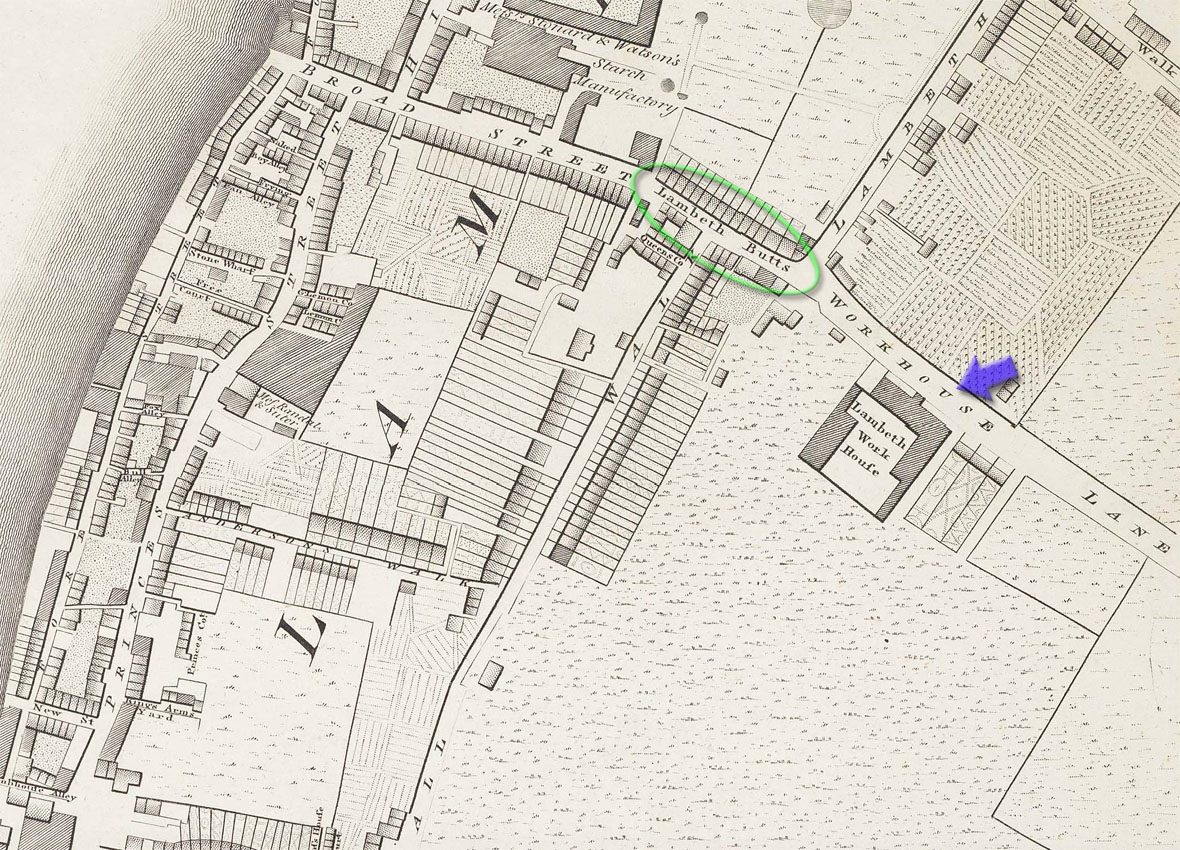
In the 1795 view below, painted by the artist Gideon Yates, we see Lambeth Workhouse from the point of view of the blue arrow in the map above.
There's a story that the dog cocking his leg at a post in the foreground represents a message to the viewer about prevailing attitudes towards the workhouse. And, I suppose, when you think about it, why else would an artist depict a dog urinating? Unless he’s attempting to win a Turner Prize... Hey c’mon, I’m not allowed a joke on my web page?
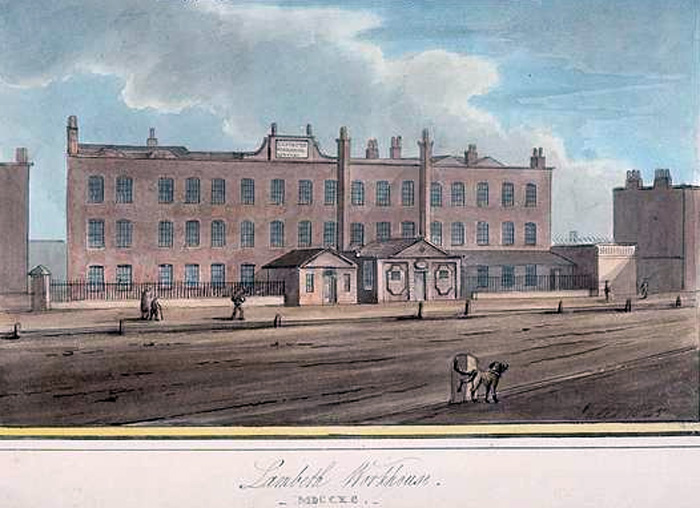
Lambeth Workhouse was built in 1726. When a street is being named today, it is generally called something like Primrose Avenue or Honeysuckle Road. But our Georgian ancestors weren’t always sentimental about such things, nor apparently did they think much about the possible effect on real estate values: so they had a quick think about a name for that lane to the new Lambeth Workhouse. And they named it... Workhouse Lane, which is how we see it in the map.
Walking in Stephen's shoes to the the western end of Workhouse Lane we come to Lambeth Butts, circled in green in the map below, and you may remember Henry VIII's Royal Statute:
"... buttes be made in everie citie, towne and place according to the law of auncient time ..."
Since by now we’re all experts on butts, we know that this may be yet another ancient archery range:

Now we need to consider the question of our Stephen, a young man of 34, a man who can read and write, who grew up in comfortable surroundings in Swallow Street in Westminster before he came to Lambeth. How can it be that this man ends up dying in the workhouse?
Let’s have a look at another map of Lambeth, this time Christopher and John Greenwood’s map of 1827:
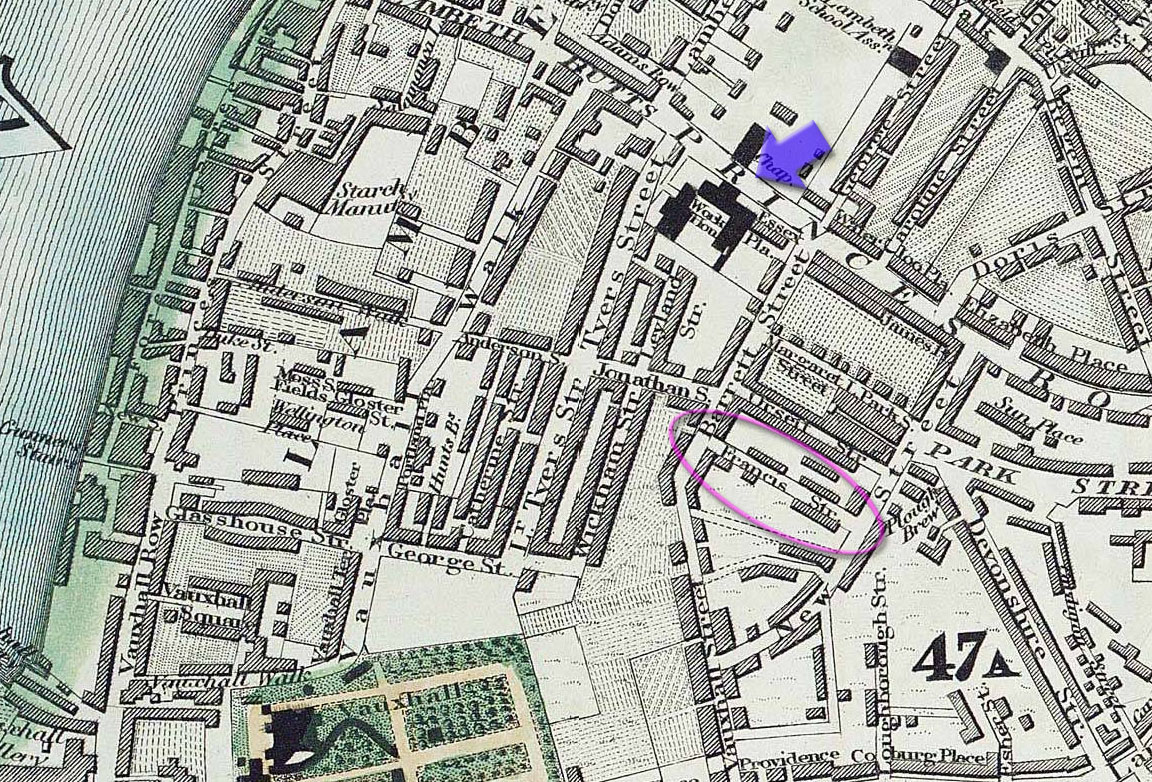
In this map we see Francis Street, circled purple. While Stephen sleeps in the workhouse, in 1836, his brother Benjamin Partleton - my g-g-g-granddad - is living with his young family 50 yards away at the corner of Francis Street and Barrett Street!
Of course we don’t know any of the circumstances which led to this state of affairs, and we’ll explore that in a minute, but first we should get to understand workhouses, and Lambeth Workhouse in particular.
Here’s a priceless source of information, published in 1797:
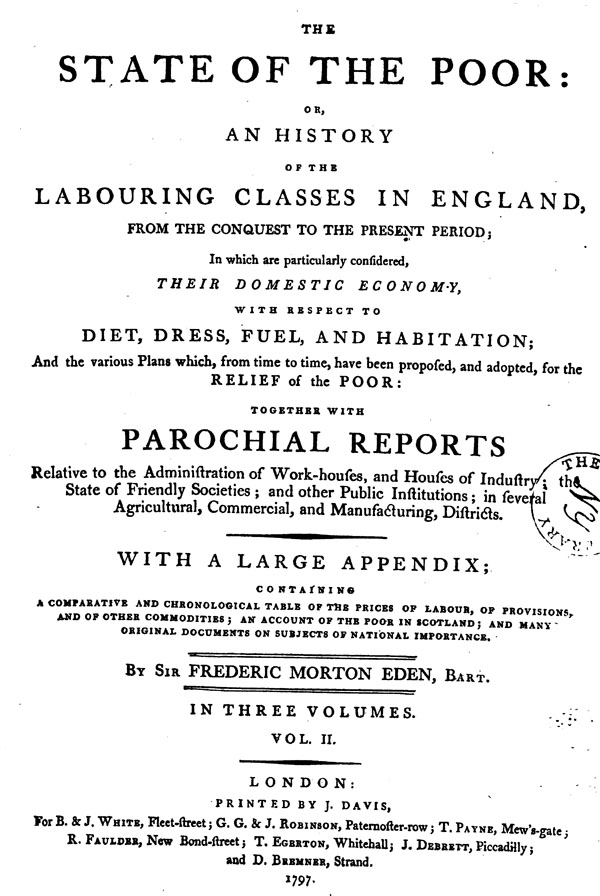
The author, Sir Frederick Morton, was interested in the differences and inequalities of the provisions for the poor from place to place, and the variations in the cost to the citizen of providing this early welfare system, the cost of which came out of the rates of local householders.
Unfortunately, I could only find Volume II on Google Books; I believe Lambeth is in Volume III, but it matters not. We can use the similarly-sized London workhouse of St Martins-in-the-Fields in Westminster as an example, where Sir Frederick records a typical menu which would have been served up in any workhouse. A rather unappetising bill of fare for our Stephen:
St Martin's at least knew the importance of rotating the diet of its inmates; some workhouses didn’t. I've heard the words pottage and gruel plenty of times in my life, with only a vague idea what they are, and I think it's about time I understood, properly, exactly what these subsistence foodstuffs entail...
Pottage consisted of a pot of oats that was kept over the fire for very long periods, and had roots, beets, bones, apple cores, and whatever was cheaply available, added to it. The result was a mush that was never quite the same twice. Pottage was typically boiled until the entire mixture took on a homogeneous texture comparable to the consistency of hummus.
Gruel, of Oliver Twist fame, referred to by cockney Londoners in the 1800s by the slang name of skilly, was a preparation consisting of some type of cereal; millet, barley, wheat, rye flour, or also rice, but most often – oats - boiled in water or milk. It is a thinner version of porridge that may be more drunk than eaten. I agree with Dr Johnson in the matter of oats - it's a meal for horses, but there's plenty of evidence that gruel was a very welcome hot dinner to the hungry workhouse inmates:

The workhouse dining-hall we see above is that of Bermondsey, just two miles up the road from Lambeth. And the photo, though it looks older, is actually post-1900. However, I think it still gives us some idea what things were like. I've tried to count the heads and the tables, and I reckon there are about 160 people sitting down to dinner in that picture. Both Bermondsey and Lambeth housed about 800, so we see the scale of the task of keeping all those mouths fed at minimum cost.
And it’s a good moment to be clear that the Lambeth Workhouse in which our Stephen died is not the same one in which Charlie Chaplin spent a few weeks when he was a child in 1896. The newer Lambeth Workhouse was built at a different location, Renfrew Road, in 1873.
The photograph below is of girls punching cardboard data cards - in an era before computers - in the 1931 census. This work was being carried out in the 'old Lambeth Workhouse', which I'm fairly sure is the original building in which Stephen died:

The Lambeth Workhouse, where Stephen died, was reputed as being rough - but not the roughest - and was the subject of a celebrated piece of Victorian journalism:

This article, published in Pall Mall magazine in 1866, was written by brave journalist James Greenwood, who spent a night disguised as a pauper in the ‘casual’ ward of Lambeth Workhouse, and makes for some scary reading, but we haven't got time to read it here, so you'll find a link to it at the end of Stephen's story.
The following cartoon was printed in Punch magazine in the same year, drawn by Sir John Tenniel:

I'm not sure if I understand the joke, but I guess it may be a swipe at Lambeth Workhouse and its lax entry policy. Two thugs are denied entry to a workhouse while a deserving mother and her child are being allowed in... "Let's cut to Lambeth!"
But there's no joking in Gustave Doré's ', engraving of 1872, 'Applying for Admission' at an unnamed refuge on a cold rainy night:

In 1833, three years before Stephen was in Lambeth Workhouse, New Monthly Magazine observed the contradiction faced by the poor:
The very poorest were better-fed and better-clothed in the workhouse than in their own homes, and they were better-fed and better-clothed in prison than in the workhouse, and they were better-fed and better-clothed after being sentenced to transportation than they would be in prison. The bigger the punishment, the better-off they were. Therefore the statement that there was no punishment for them:

I don't think we should read too much into this cutting. The workhouse was dreaded, a last resort avoided by all.
That the Lambeth Workhouse was no holiday camp is demonstrated in this report of January 1834:

Mr Rowe got off with his crime because the boy had severe lung disease which the coroner determined to be the the cause of death, not the beating. The newspaper disapproved.
So, we've gone off track... we were trying to figure out how Stephen ended up in the workhouse and why he died so young. He died in 1836: if he'd lived just one more year we could have a look at his death certificate because compulsory national registrations of deaths started in 1837. Too bad. And the Lambeth Workhouse records of admissions and discharges for this period seem to be tantalisingly missing; it would be great if we could find those, and they may turn up yet.
But perhaps we can learn something by having another look at his family tree:

From this we can see that Stephen's next younger brother, Thomas, died just two years later, in 1838. He was only 34. He died of a stroke, and his young family, without its breadwinner, spiralled into calamity. Some of his young children died and the two survivors ended up in the workhouse along with his wife, Ann Rebekah George, who died in Walworth Workhouse.
And Stephen's older brother Benjamin died just a few years later, in 1843, of... a stroke. Benjamin's family was also shattered by his death but seem to have avoided the workhouse with the support of his widow Mary Greenwood's family.
So it may be that Stephen went into the workhouse simply because he fell ill. The Lambeth Workhouse had a sick ward, recorded in numerous obituaries of the 1800s, an example of which we see below:

Six years after Stephen's death comes the first full UK census, again another missed opportunity where we could have had a closer look at Stephen and his potential family, but we can at least use the opportunity to have a closer examination of Lambeth Workhouse:

Perhaps we'll remind ourselves what the workhouse looks like. It's the last place our Stephen ever sees:

Let's go through those forbidding front doors and have a peek inside at its occupants:

Men and women were of course, segregated, and we're looking at a typical page from the men's ward in Lambeth Workhouse. As we can see, most of the inmates in the workhouse are old people. There's no state pension: if you got old and had no family able or willing to look after you, and you hadn't saved any money, then you ended up in the workhouse.
The workhouse was traditionally less busy in the summer, but I counted 720 people in the census in the workhouse on this night, 06 June 1841. The majority were either over-60, under-15 or single-mums with babies. These three groups made up over 80% of the occupants.
John Weale, in his Pictorial Handbook of London, published in 1853, gives us a nice succinct description of how workhouses and the Victorian welfare system worked:

From this same book, below we see confirmation that Stephen is not so much in the workhouse, as in the hospital:

My point is that I think it's a mistake to think of Stephen as a pauper or workhouse resident. He probably just got very ill and spent his last days in the workhouse infirmary.
Stephen Partleton was buried on 08 April 1836 at Lambeth Burial Ground, the gates of which we see in an engraving of 1828 below:

So we may step into the shoes of his family gathered at Lambeth High Street for the funeral.
Looking through the cemetery gates, we see a church spire, and if we look at the map below, and follow the dotted green line from the artist's viewpoint at the green arrow on the High Street, it is clear that this is the church of St Mary-the-Less, outlined in red, directly opposite Lambeth Workhouse, outlined in purple:

And that seemed to be the end of Stephen's story.
But everything changes, and new evidence emerges...

In November 2011, The British Library announced that it was going live with an online archive of scanned images of 40 million pages of British 18th- and 19th-century newspapers, one of which was the Bath Chronicle.
This esteemed publication cost sevenpence - a small fortune in 1836 - especially when we consider that it only had four pages. But on one of those pages, we find the following little nugget of information:

So, we discover that in the January of 1836, three months before his death, poor Stephen had visited the city of Bath to take its waters which were reputed to have healing powers.
Bath Hospital was - predictably - making startling claims in the local newspaper about the efficaciousness of its mineral water. In the case of Stephen Partleton, they didn't claim he was 'cured', merely that he was 'much better'. The newspaper article tells us that Stephen Partleton was suffering from 'dropt hands' [dropped hands]. That is somewhat quaint old-fashioned terminology, but the distressing fact is that at least one, possibly both, of Stephen's arms were paralysed.
What could the cause of that that be? Well, a bit of research shows that dropt hands was a common syndrome among males in the 19th century, with a well-understood cause. In that newspaper article, there are five cases of dropped hands in addition to Stephen, all of whom are men. But it's no use looking on modern medical websites for a diagnosis, because it's not something from which people suffer in our modern era.
I found the diagnosis quite easily in 19th-century textbooks. But I'm going to keep you in suspense for a bit because I want us to take a step back to 1836, and to journey with Stephen from London to Bath:
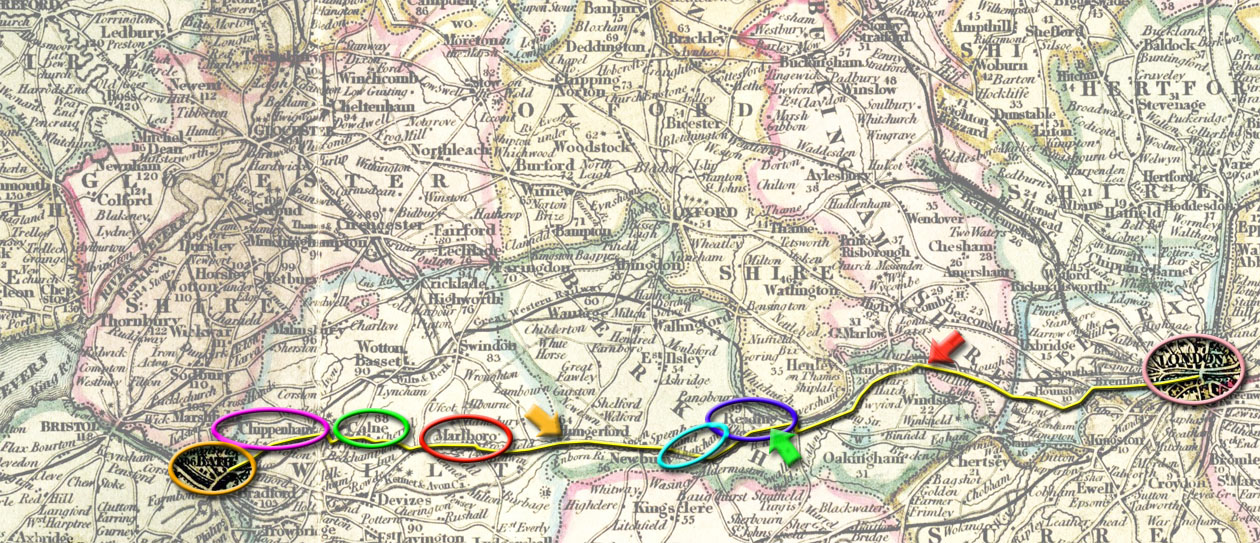
So, though Stephen surely ain't in the mood for sightseeing, we are. Let's step into his shoes for his journey from London to the famous spa-town of Bath to take the cure.
He made the 112-mile journey in a horse-drawn stagecoach - there was no other way to travel unless he walked[1]. These departed London for the west from a number of coaching-inns on Piccadilly. Below we see one of them, depicted by James Pollard in 1828; titled West Country Mails at the Gloucester Coffee House, Piccadilly :

Piccadilly is very familiar territory to Stephen Partleton. The house where he grew up as a child, on Swallow Street, is circled in yellow below. The Gloucester Coffee House was on the corner of Piccadilly and Berkley Street, seen in Pollard's painting from the viewpoint of the red arrow in the map below:

Actually we are going to choose to leave London with Stephen from outside Hatchett's Hotel, seen in the background of the comic cartoon below, drawn in 1818 by caricaturist George Cruikshank, from the viewpoint of the blue arrow in the map above.
George gives us some insight into the continuous bustle and chaos of the coaches and travellers on Piccadilly. Pretty uncomfortable for a sick man like Stephen Partleton:
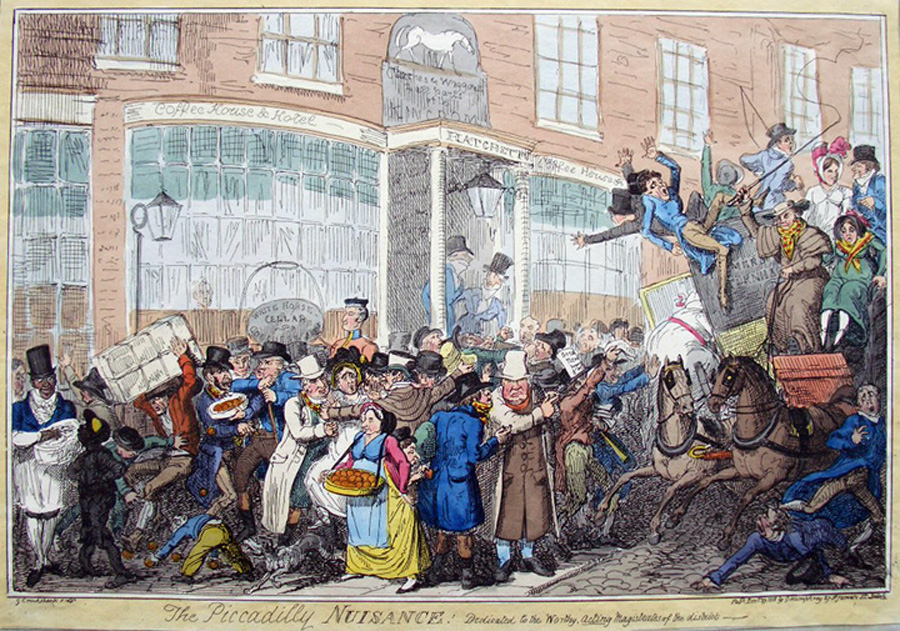
I found an advert for Hatchett's in one of Bradshaw's travel guides of 1857:

Artist James Pollard loved to paint horses and coaching scenes. Below he gives us a very similar view of the traffic chaos on Piccadilly outside Hatchett's:

Piccadilly is the London end of the Great West Road - the modern A4 - which goes all the way to Bristol. Bath is close to Bristol - and for much of its length, this thoroughfare is also called the Bath Road, which is how I will refer to it on this page.
In 1836 there were ten coaches departing for Bath every day from London, operated by five different companies in sharp competition with each other.
We see the location of the Gloucester Coffee House and Hatchett's Hotel at the point of the red arrow in John Cary's handy turnpike map of London of 1801 which we see below:

And as a further illustration of the day that Stephen set off, below we see a superb pencil drawing by George Scharf (1788-1860) who stood on Piccadilly in 1829 and recorded a lively scene full of scrumptious detail. This coach is setting off from Piccadilly westwards for Falmouth in Cornwall - 275 miles.
The passengers and drivers are well-wrapped up against the cold for a long, long haul if they're going the whole way; 275 miles. Not just men but women and children perched up top, and a bunny rabbit - presumably someone's lunch - among the baggage:

Stephen's coach is not going quite so far, but it's still going to be a long arduous journey westwards to Bath - 13 hours.
But it's only a very short while - just a few minutes - before the coach encounters the Hyde Park Gate, the first of many turnpikes, where it has to pay a toll. The turnpikes paid for the maintenance of the road.
As we pass through Hyde Park Gate, and turn back to look towards Piccadilly from the viewpoint of the green arrow in the map above, we see Stephen's stagecoach passing the gate, illustrated by the 1820 engraving below. Since this is the Bath Road, the coach certainly passed this point as it exited London.

We get the same view on the front cover of The Picture of London published in 1825:

Stagecoaches held four passengers inside. Stephen has paralysed arms, and I can't imagine that he was in a fit condition to bounce and sway on top of the coach. A passenger will surely have to hang on tight up there as the coach jounced and bumped and rocked along the rutted 19th-century country roads. So I'm assuming that he sat inside.
I wonder how much his ticket cost?... let's try to buy one. For this we will consult the Bath Chronicle, of 1837, a year after Stephen was in Bath...
On page 2 we find an advert for the New Stage Coach Company, offering journeys between London and Bath:

This particular coach company linked up with Hatchett's Hotel on Piccadilly, which is why I chose it for our journey, so let's review the route specified in the advert:

At Maidenhead, at the point of the red arrow in the map above, the Bath Road crosses the River Thames.
And as we pass over Maidenhead Bridge in Stephen's stagecoach, there's another toll gate, as we see in the painting of Maidenhead Bridge below

Here's Maidenhead Bridge today, and in 1880; built in 1777, it's the same bridge which Stephen crossed:
 xxxxxxx
xxxxxxx
Now we have crossed the Thames and we continue our journey westwards, we'll be guided by milestones to track our progress.
As we pass Reading, we still have a full 72 miles to go:

Stephen Partleton's stagecoach clattered within a few feet of this very milestone on the Bath Road.
It was there in 1836, at the point of the green arrow, and - like many others - still stands today.

Reading, circled blue in the map, is one of the waypoints mentioned in the New Stage Coach Company's advert, as is Thatcham, a couple of miles further on, circled in turquoise.
It's obvious that Thatcham is half-way along the road on our map, so it is no surprise that it was chosen as the place where the tired passengers could stop for a break and take some lunch, as specified in the advert in the turquoise circle:
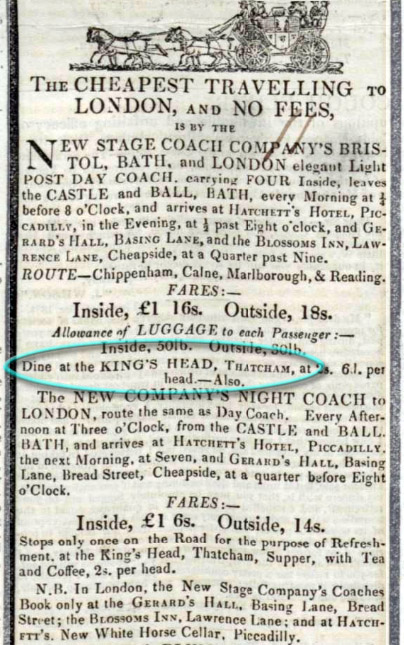
Let's get out for a bit and stretch our legs, illustrated by this sketch:

The seats inside a stagecoach are called... well... insides. And since the passengers have to cover the costs of four horses, two coachmen, turnpikes, changes of horses etc, etc, it's no surprise that Stephen's inside ticket ain't cheap. If he takes lunch at the King's Head, Thatcham, he'll have to stump up an additional two shillings and sixpence, and the cost of his journey will now be nearly two pounds.
The King's Head in Thatcham is still there in its Georgian glory:
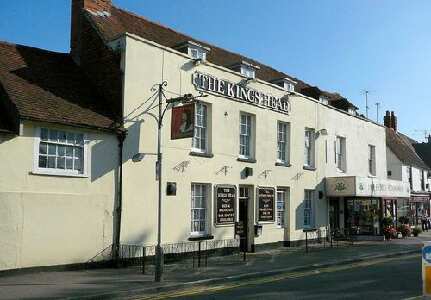
It's a good moment to consider Stephen's terrifying, helpless, paralysed condition; dropped hands. If he dines at the King's Head, he won't be able to hold his knife and fork. Someone will have to feed him. He will be unable even to go to the toilet without assistance... So what was this affliction which caused healthy adults to lose motor control of their arms, and moreover - I can reveal - only affected men? I'll give you another clue and reveal that it was an occupational hazard. The Partletons were house painters. Had he fallen off a ladder?
We have assumed he was accompanied on the journey, not by us of course, but hopefully by a family member, in which case the cost is now nearly £4 for two people... and that's just for a one-way trip.
How can we relate to that cost? Was £4 a lot of money? Well, yes, it was a lot of money; a month's wages. I found this reference to a painter's wages in the Bucks Herald of Saturday 15 January 1848. This painter was earning 1 pound 4 shillings a week:

But we're not in a mood to worry about money. This journey is aimed at saving Stephen's life. In any case, as we shall see, Stephen's treatment in hospital was funded by charity, and I'm guessing his travel costs were probably also subsidised.
We should finish our lunch and get back into that boneshaker for the next stage of our journey. Drink up; after Thatcham we still have over 6 hours travelling ahead of us.
Oh, but, hold on, while we sup the remains of our pint of beer, let's review the options which were available to us for the stagecoach trip:

What is surprising - as revealed in this advert - is that stagecoaches travelled both by day and night, as evidenced by the blue circle, despite only very primitive oil-lamp lights to illuminate the way. On pitch-black nights, it must surely have been extremely difficult for the coachman - or the horses - to see they were going, even at walking pace. If our Stephen needed to save money, he could, potentially, have endured the night ride. The slow journey jouncing through the darkness departed at 3pm and arrived at 7am; sixteen hours. Brave passengers sat outside in the winter in the middle of the night in the rain and snow. Let's face it, the poor driver had to.
Anyhoo, let's hope Stephen with his dropt hands is able to travel by day.
Now we're out of London, we can use this 19th-century painting of a stagecoach to visualise the next section of Stephen's journey to Bath. There's going to be a lot of jostle and boneshaking for a sick man inside that cab. The picture is titled behind time and is by an anonymous artist:
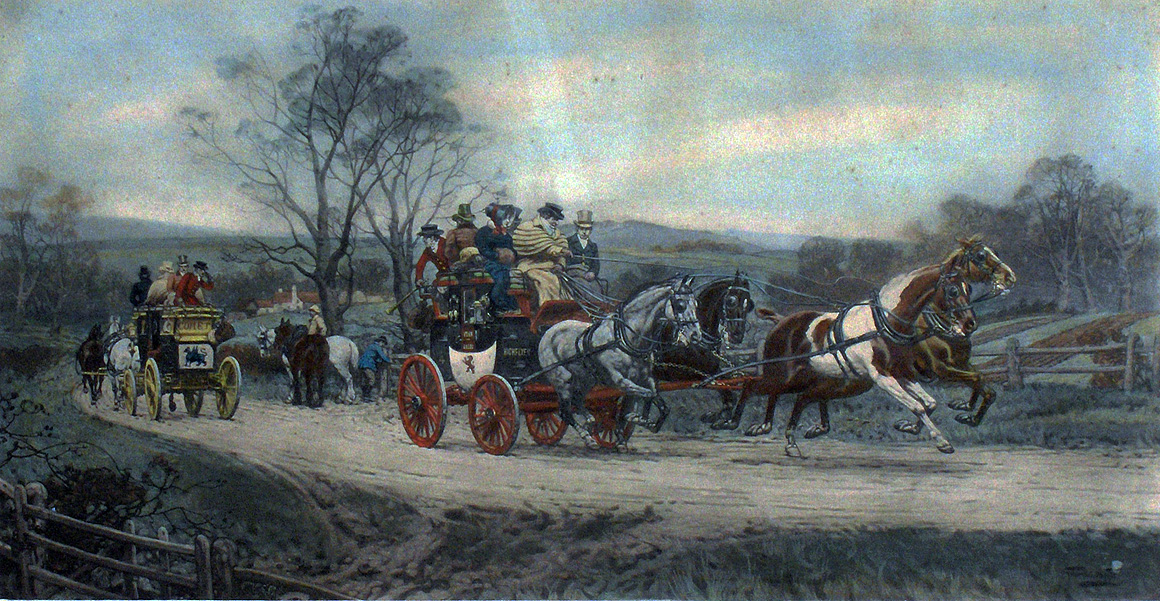
Further west, at Hungerford, we get a wonderful contemporary photograph of a toll gate, seen below.
The rights to tolls could be bought and sold but were often owned by associations of the landowners along the route. In the c1850 photograph below we see the tollkeeper, in this case a woman, posing with her kids outside the cottage where she resided.

Stephen Partleton didn't see this particular gate, though he would have seen numerous others like it.
It's very close to the Bath Road at Hungerford, but it's not on the main road. It's at the point of the orange arrow in the map below:

Tolls were predictably unpopular with road users, especially as the roads were still usually poorly maintained. The inefficient and unreliable toll system was gradually phased out during the 19th century.
The last remaining toll booth on the Bath Road - the Maidenhead Bridge gate, which both we and Stephen Partleton saw earlier at the point of the red arrow - survived until Saturday 31 October 1903, when there was an amusing reaction from the public, according to the Lincolnshire Chronicle of Friday 06 November 1903:

Getting back en route, to Hungerford, near the point of the orange arrow , we read of a 183-year-old tragedy which took place on the stagecoach on the Bath Road, as reported in the Leicester Chronicle, quoting the Devizes Gazette on Saturday 23 August 1828:

Looking at the stagecoach painting, it's fairly clear how the incident happened:

Anyhoo, we're getting tired from our long journey. Let's take a look at the town centre of Chippenham, near the end of the road, circled in purple in the map above:

Obviously the kids standing in the market square are Edwardian, but I'd wager this scene would have appeared identical to our Stephen as he passed through Chippenham near the end of his journey, 70 years earlier.
The horses trot on past Chippenham, and soon enough, our coach arrives at our final destination; Bath, nestling in a loop of the River Avon::

The map was drawn in 1836, the very year our Stephen was in the city. It is from Thomas Moule's The English Counties Delineated.
Let's dig out that 1837 advert for one last look:
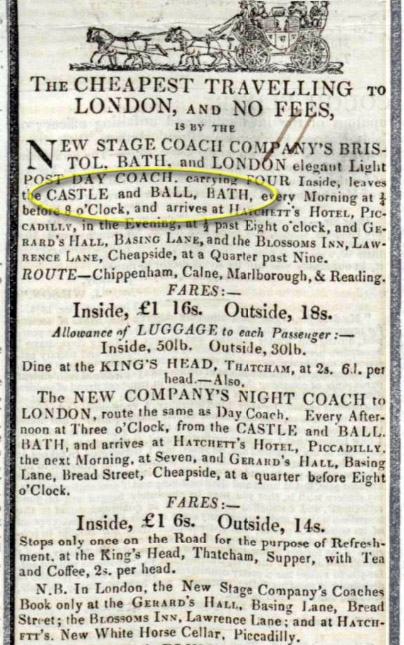
The yellow circle in the advert tells us that the coach terminated in Bath at the Castle and Ball pub, in the historic centre of this ancient town.
The Castle and Ball was located in Northgate Street, at the point of the yellow arrow in the map below:

The Castle and Ball was later renamed as simpy The Castle which is how we see it in the undated Victorian photograph of Northgate Street below, when it was clearly still a coaching inn:

Here's Northgate Street today, from the viewpoint of the yellow arrow:

I can't see the Castle Hotel building on Google Street View, so I'm assuming it has been replaced, but tell me if you know differently.
The hospital is at the point of the green arrow in the map below. Our Stephen only had 100 metres or so to walk from the coach-stop at Northgate Street:

It's still a hospital today; not for the taking of the waters, but for treatment of rheumatism.
Below we see it in 1912 from the viewpoint of the green arrow. It looks exactly the same today:
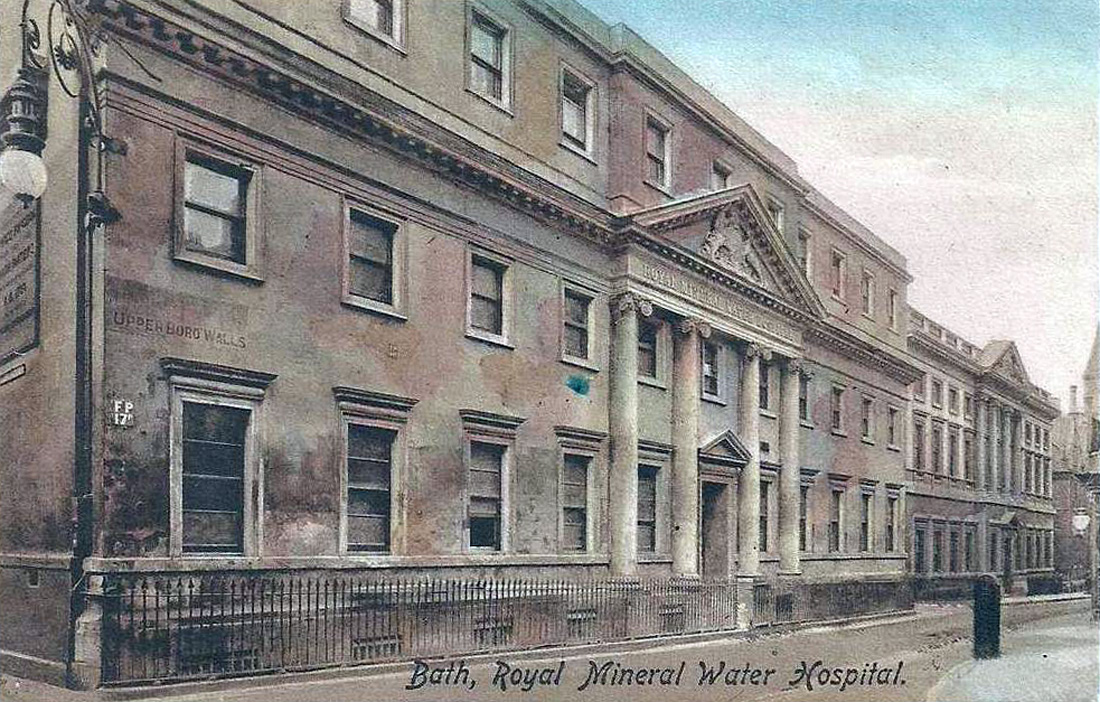
In 1836, Stephen Partleton was in one of the rooms we see above.
But Bath was a city where the rich went to get cured. How could Stephen afford it?
In the 1830s engraving below, drawn by artist Woodroffe, we see the hostiptal - the building on the left - exactly as Stephen saw it in 1836:

The Georgian engraving we see above was drawn from the viewpoint of the blue arrow in the map below:

Now that we've arrived at our destination, we should review the newspaper report which led us here:

We learn from The Medical History of England that Bath Hospital had been founded in 1738 specifically to allow poor people access to the healing waters of the city, free of charge:
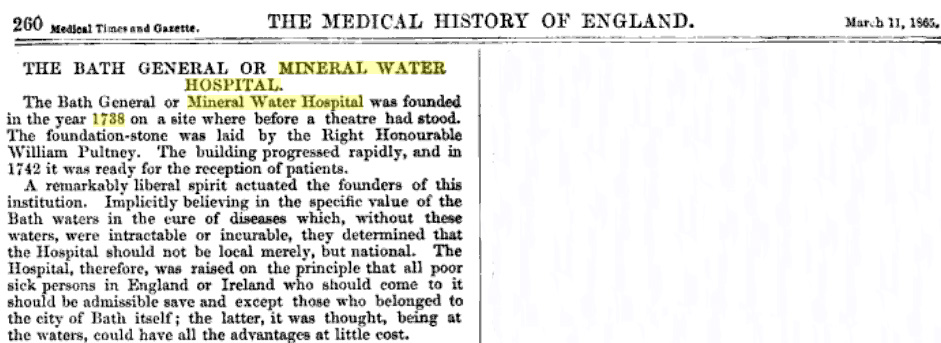
So now we know how the working-class Stephen could afford to be in the hospital. His treatment was provided free of charge by charity.
Stephen qualified for a place in the hospital because his condition, dropped hands, was one of the very specific ailments stipulated as a requirement for the 'Admission of Patients' in Bath Hospital's rules, laid down in 1738:

Ah, and we have seen a clue about Stephen's condition in the rules for admission... 'dropped hands from lead'.
That description, though it carries more information than we had before, is still too vague. But a little research reveals the full story. The poor fellow in the article below, a house painter, was also admitted to Bath Hospital with dropt hands:

Now we understand what was wrong with Stephen. His paralysed arms are a terrifying symptom of lead poisoning.
Lead poisoning was so completely associated with one particular occupation that in the 18th and 19th centuries it had a common name... painter's colic.
We have no records showing Stephen's occupation, but we know exactly what his brothers were doing, because this information was recorded when their children were baptised...
This is Stephen's big brother Benjamin (b1799):

This is his younger brother Thomas (b1804):

And this is his brother James (b1806):

The Partleton family trade was house-painting.
Lead compounds were added in vast quantities to paint in the 19th century. For colour; 'White lead' - lead carbonate - was the commonest, giving a good opaque white coat; lead chromate created yellow. Numerous other lead compounds were also added for their useful properties such as quick-drying, durability and moisture-resistance. Georgian and Victorian paint was absolutely stiff with lead.
Our modern experience of buying paint is misleading. We just pop out to B&Q, choose a colour, and buy a tin off the shelf. 19th-century house painters didn't have this luxury - they sometimes had to grind the dangerous dry raw ingredients and make up the paint themselves, being exposed to powders, vapours, liquids and skin contact, inhalation, even ingestion if they weren't careful about washing their hands. Many lead compounds taste sweet and are not unpleasant, which adds to the danger of careless ingestion.
Lead paint continued in use in the 1960s. It was banned in the USA in 1977. Below we see a can in the USA, probably originating from the 1950s... 'Avoid prolonged contact with skin... Cleanse hands thoroughly':

Dutch Boy as seen on the tin above was - and still is - a major paint brand in the USA, though of course the paint they sell now does not contain lead.
Here's an extraordinary piece of Dutch Boy advertising material from 1923, drawing attention to the 'happy family' of lead-based products in the home. Lead toys, lead crystal, lead in pewter etc. Of course, as we have seen, the catastrophic toxic effect of lead in the human body had been very well known for hundreds of years, so I'll leave the gentle readers to draw their own conclusions about this piece of cr*p:
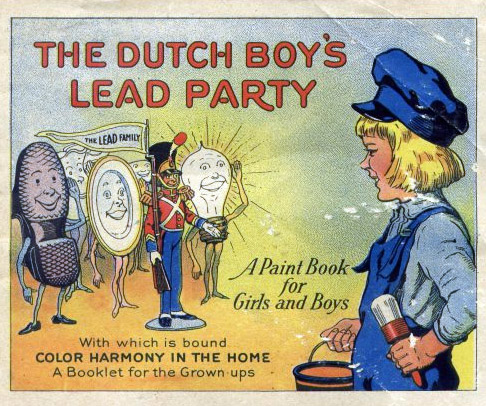 xxxxxxxxxx
xxxxxxxxxx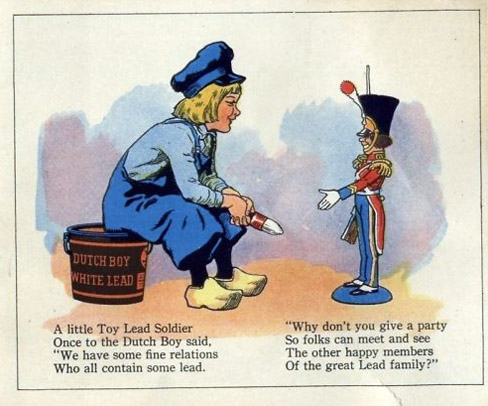
Let's get back to Stephen in 1836. Most of us have done a bit of painting, and I'm sure you'll agree that it's pretty hard to keep it off your hands. And 19th-century paint was much more runny, drippy and uncontrollable than modern paint. Furthermore, Stephen probably doesn't have a whole lot of time, or the facilities, to keep washing his hands all day. Stephen's poisoning most probably came from lead being absorbed through paint caked on his fingers, hence the dropped hands.
We get some very interesting and detailed insight into the day-to-day unpleasantness and hazards faced by Stephen as he painted houses in the 1830s from the Hertford Mercury and Reformer of Tuesday 30 August 1836:
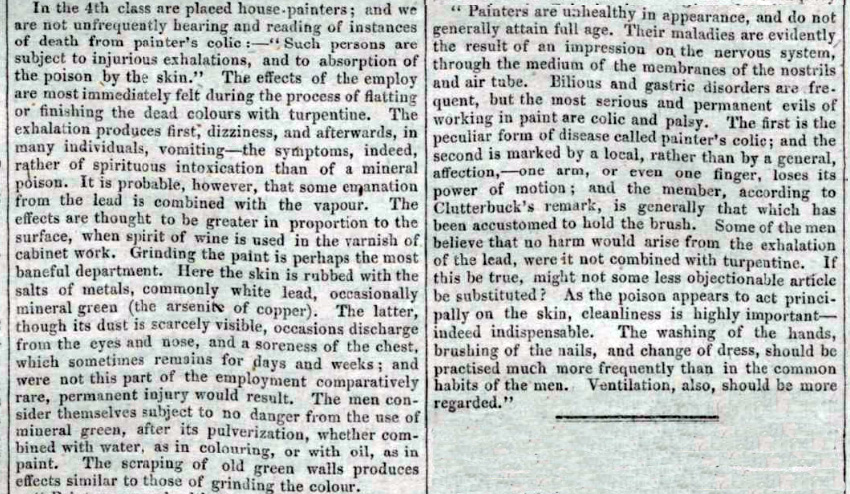
It's quite possible that Stephen's treatment at Bath may have improved his condition. Lead is gradually excreted by the body; the health of victims improves when they are removed from the source of poisoning. Stephen got some rest, was well-fed, cared-for, and importantly was separated from the lead which was poisoning him. But he was very ill.
Dropped hands were not the only unpleasant symptom of lead poisoning - colic means severe abdominal pain; he would have suffered headaches, difficulty concentrating, numbness and had a continuous metallic taste in his mouth. He may also have had a diagnostic narrow blue line on his gums and even bluish saliva, God forbid such a ghastly symptom. And not all of the lead in your body can be excreted. Some of it finds a comfortable home in your bones and in your brain and, once there, it doesn't go away. Poor Stephen must have felt very ill indeed.
He returned to Lambeth in 1836, but died in April of that year.
Indeed, in that very year, 1836, as Stephen made that 13-hour stagecoach journey, plans and land-surveys were already in progress to supersede it with the Great Western Railway, as the potential route was discussed in the American Railroad Journal of 1836:
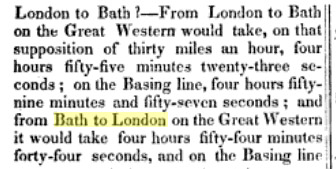
The Great Western Railway Company had been founded in Bristol in 1833, and the line was approved, as required, by Act of Parliament in 1835. Its chief engineer was Isambard Kingdom Brunel.
The company found it very easy to attract investors; railways were promoted as a foolproof venture, and Railway Mania had started. Shares in railways could be purchased for a 10% deposit, with the railway company holding the right to call in the remainder at any time. After you'd paid your deposit, you had better be sure you could pay the rest. Tens of thousands of middle-class investors lost their savings over the next decade as the Railway Mania bubble burst. It turned out that everyone was being far too optimistic about just how expensive railways are to build, to maintain and to run at a profit.
Here's the Great Western company calling for its third instalment in the Exeter and Plymouth Gazette on Saturday 09 April 1836 - precisely one day after Stephen Partleton was buried:

The railway to from London to Bath, completed five years later, shaved a massive 7 hours off the journey, despite its meandering route which we see highlighted in blue in the 1840s map below.
Unsurprisingly the stagecoach companies' long-distance business collapsed as soon as the railway to Bath opened in 1841.

Although the first passenger steam-railways in the world had started in Britain in the early 1830s, the first railway in London - the London and Greenwich Railway - from London Bridge eastwards, didn't commence until February 1836, just a few weeks before Stephen passed away.
Stephen, living in Lambeth, would certainly have heard of the new marvel of trains, but probably didn't see one in his lifetime.

Before we close this page, we should review the scant evidence which led us to Stephen. We don't have his baptism[2], despite baptisms for all of his brothers and sisters, whose christenings were clearly recorded at the church of St James Piccadilly... all except one, that is. His brother James was christened in 1806 in Isleworth, miles from Piccadilly. Something similar could explain Stephen's absence from the Parish Register.
And Stephen never married, which eliminates another source of evidence we would normally rely on. And furthermore, his name was spelled incorrectly at his burial, making him hard to find. And he never lived long enough to be recorded in a census, or to get a death certificate.
But his signature at his brother's wedding is compelling and complete proof of his existence. Furthermore, I've got to say that he must surely have had a son called Stephen. There's no other explanation for signing one's name Stephen Partleton Sr. ... If Stephen Jr. was illegitimate, he would have his mother's surname, and it's hard to see how we could ever trace him.
To summarise, Stephen Partleton Sr...
"... we found you..."
Footnotes:
[1]After I published this page in December 2011, the Partleton Tree received numerous helpful emails from its correspondents. The first one is from historian Ruth Richardson:

Click here for a link to Ruth's very interesting-looking book which she mentions in her email.
[2] Three correspondents - Nesta Blundell, Phil Jackman, and Alison Day noticed that the parish records for Isleworth, west of London have recently been scanned and added to the records in Ancestry.co.uk... lo and behold, Stephen Partleton's christening appeared in the Register of Baptisms for All Saints Church, Isleworth, where his brother James was baptised five years later. Stephen was baptised on Boxing Day 1801:
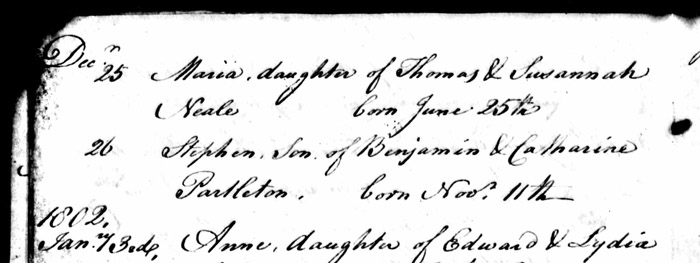
As a post-script, now that we know that Stephen Partleton died of lead-poisoning aged 34, we ought to worry about his brothers who were also in the house-painting business. According to the Hertford Mercury and Reformer, they might not 'attain full age':
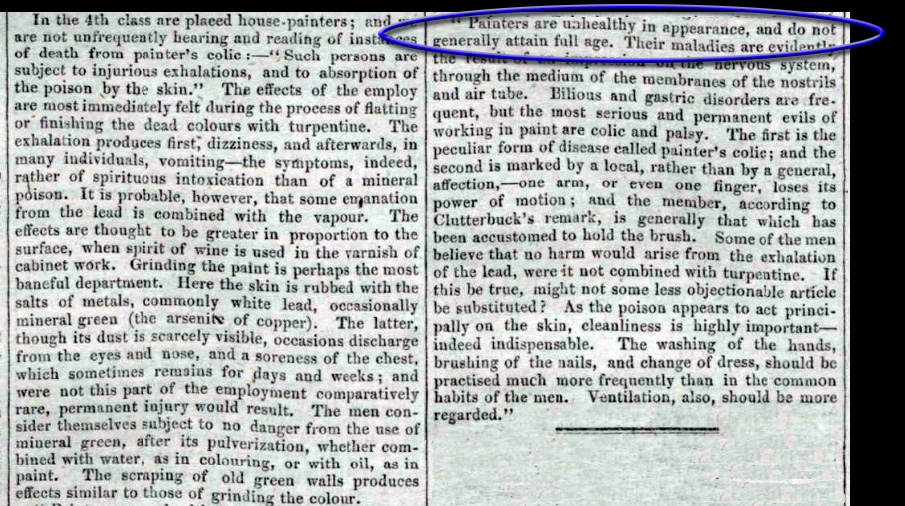
Stephen's brother, Thomas Partleton died in 1838, at age 34, exactly the same age as Stephen. Coincidence? And older brother Benjamin (who is my 4 x great-grandfather), died in 1843, aged just 44.
These are unusual ages to die, even in the 19th century. Both Benjamin and Thomas died of stroke, according to their death certificates, both of them leaving young families to spiral into catastrophic poverty, so let's look up a modern study of the effects of lead poisoning and apply some amateur medical diagnosis...

It seems that exposure to lead and increased risk of stroke are indeed connected.
The above study, published in Environmental Health Perspectives in March 2007, is titled Lead Exposure and Cardiovascular Disease - a Systematic Review and was undertaken by Ana Navas-Acien, Eliseo Guallar, Ellen K Silbergeld and Stephen J Rothenberg.
Given the above conclusions, and the early deaths of Thomas and Benjamin Partleton in 1838 and 1843, we may wonder if they also had their health compromised as a result of their occupation...
Which leads us to another of those insane lead paint adverts, sponsored by the Lead Industries Association, in the Agricultural Leaders' Digest in the 1940s: 'The higher the lead content, the better the paint'...
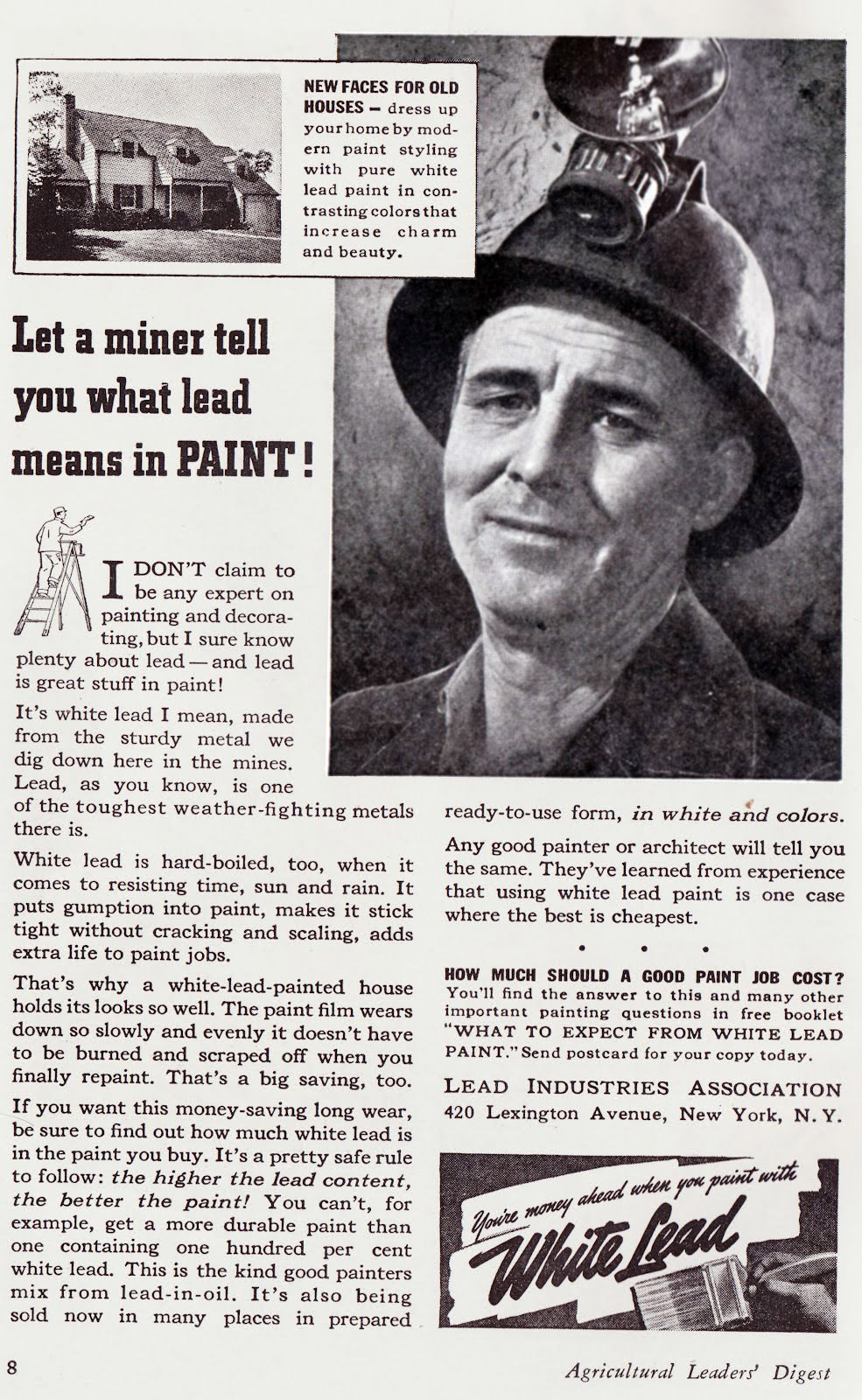
And, as promised, here is a link to the fabulous piece of investigative journalism by James Greenwood, 'A Night in the Workhouse'. If anyone wants reassurance that Britain is a better place now than it was 150 years ago, it is highly recommended reading.
If you enjoyed reading this page, you are invited to 'Like' us on Facebook. Or click on the Twitter button and follow us, and we'll let you know whenever a new page is added to the Partleton Tree:
Do YOU know any more to add to this web page?... why not send us an email to partleton@yahoo.co.uk
Click here to return to the Partleton Tree 'In Their Shoes' Page.
